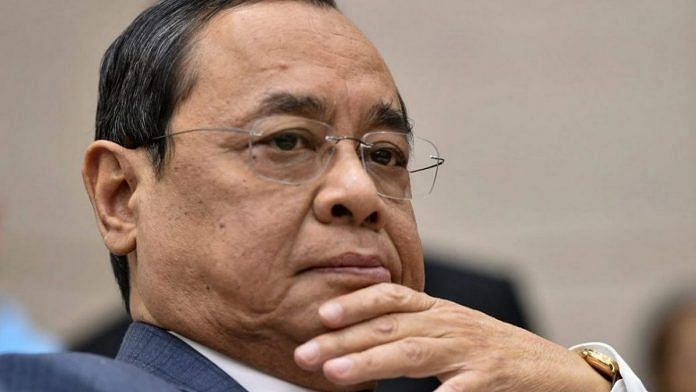New Delhi: The recently retired Chief Justice of India (CJI), Ranjan Gogoi, has accepted his nomination in the Rajya Sabha. For a CJI, this is an unprecedented action.
However, Gogoi isn’t the only CJI to take a job after retirement. A study by the think-tank Vidhi Centre for Legal Policy has shown that 70 per cent of judges in the Supreme Court get government jobs.
Another study — Jobs for Justice(s): Corruption in the Supreme Court of India — states that the odds that a Supreme Court justice gets a post-retirement job is increased by 15-20 per cent with every judgment that is favourable to the government.
Also read: Gogoi picked for Rajya Sabha — 2017 study tells us how judges manage to land such benefits
Five levels of honourability
Sixty-five is a very young age to retire, so many judges do work after that. We give five levels of honourability to the post-retirement work judges do.
First, some judges take up a private job and not any public posts. The three previous CJIs — justices T.S. Thakur, Deepak Mishra and Jagdish Singh Khehar — have done this. They have used their experience and skills in other areas.
Second, some judges get appointments from the Supreme Court itself. One such example is Justice R.M. Lodha who was handed the BCCI case.
Third, some judges become politicians but continue their judicial appointments at the same time. V.R. Krishna Iyer became a Supreme Court judge after being a minister in Kerala’s Communist Party government. Justice Koka Subba Rao resigned from the Supreme Court to be the opposition’s candidate for President. These people have not hidden their political positions, which is honourable.
Fourth, judges who take statutory jobs. These are posts with body’s like the National Green Tribunal and the National Human Rights Commission. Eventually, politicians are the ones who assign these positions and they don’t necessarily do it on the basis of a judge’s merit.
Fifth and finally, judges who get sinecures. Justice P Sathasivam was appointed Governor of Kerala by the Narendra Modi government in September 2014. He was part of the Supreme Court bench that quashed a second FIR against Amit Shah in the Tulsiram Prajapathi case in April 2013.
Getting a nominated position in Rajya Sabha is perhaps the lowest in the list. A nominated member doesn’t even get enough say on matters, if any. If Justice Gogoi is asked to vote on a divisive issue, he will have a tough time.
Also read: Justice Markandey Katju on why shoving corruption by judges under the carpet won’t help
Three interesting judges
First, Justice Baharul Islam was in the Congress party, resigned from Rajya Sabha, became a judge and then became a Rajya Sabha member again. He contested during the Assam agitation when everyone else was boycotting the elections.
Second, M.C. Chagla came back from England in 1922 and become Mohammed Ali Jinnah’s secretary. After a disagreement with Jinnah on the two-nation theory, he formed his own party — Muslim Nationalist Party. In 1948, he became the Chief Justice of the Bombay High Court till 1958. After that, he was the education minister from 1963 to 1966 and the External Affairs minister till September 1967.
Third, Justice Hidayatullah was Chief Justice of India from 25 February 1968 to 16 December 1970. Justice Hidayatullah briefly served as the vice president of India in 1969 when President Dr. Zakir Hussain suddenly died, resulting in then Vice President V.V. Giri taking over as interim president. In 1978, Justice Hidayatullah was elected vice president unopposed and served from 31 August 1979 to 30 August 1984.
In conclusion, India’s judges serve very little time as chief justices. A suggestion would be to extend the retirement age till 70 on the condition that any statutory position has to be given within the tenure of the judge.
Also read: Increase number of SC judges, raise retirement age: CJI Ranjan Gogoi asks PM Modi
Watch the full episode here:




you are totally wrong justice. J Hidayatullah, was the 11th Chief Justice of India serving from 25 February 1968 to 16 December 1970, and the sixth Vice President of India, serving from 31 August 1979 to 30 August 1984. He had also served as the Acting President of India from 20 July 1969 to 24 August 1969 and from 6 October 1982 to 31 October 1982.
You forgot Vijay Bahuguna who retired as a senior judge early to pursue politics and became Chief Minister of Uttarakhand in the Congress.
Might I point out an error in your “story” of Justice Hidayatullah?
You state: Justice Hidayatullah briefly served as the vice president of India in 1969 when President Dr. Zakir Hussain suddenly died, resulting in then Vice President V.V. Giri taking over as interim president.
Justice Hidayatullah did not serve as Acting Vice President, but, actually, as Acting President (technically, “Chief Justice Acting as President”), when V V Giri resigned from Vice Presidency to contest the election for President. He served as Acting President for about a month, I believe.
[He did not move into the Rashtrapati Bhawan and continued working as the Chief Justice. However, to my recollection, the flag of the President was flown at the Supreme Court Building (or maybe it was at the CJI residence?) to signify the authority.
VV Giri, after the death of Dr. Zakir Hussain, was also called “Vice President Acting as President” and not “Acting President” because the Constitution did not have the provision of calling anyone “Acting President”.